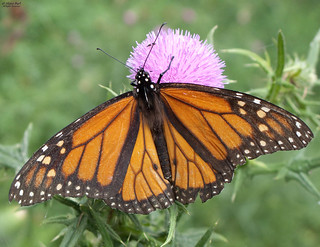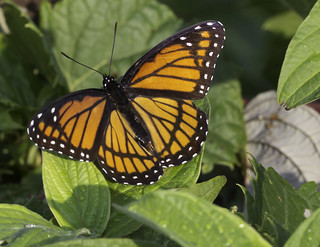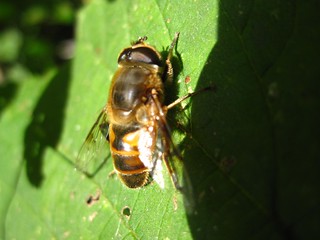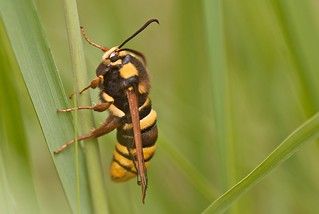When I was in elementary school, I learned that it was “aerodynamically impossible” for bumblebees to fly. Even at that age, it was a clue that humans still have a lot to learn from nature! As it turns out, bees (and other insects) fly more like helicopters than like birds or fixed-wing airplanes, and studying how they fly has led to innovations in the design of tiny autonomous flying robots (useful for surveillance, search and rescue, playing the James Bond theme, etc.). Similarly, the unique way that hummingbirds fly (combining elements of insect and bird flight) is providing clues to building flying machines that can better handle windy conditions.
DelFly Micro, a small camera-carrying ornithopter,” Copyright Delft University of Technology (www.DelFly.nl)
Copying nature isn’t a uniquely human pursuit; plants and animals have been doing it for a very long time. For example, both Monarch & Viceroy butterflies have a very similar appearance (despite belonging to different genera), and both contain toxins that make them an unpleasant meal. As these two species evolved towards a common appearance, they benefited from an increased chance that a predator had already learned to avoid orange and black striped butterflies after suffering from a bitter taste and an upset stomach. In this case, both species benefit by looking the same (which scientists call “Müllerian” mimicry) as they both get eaten less.
 |
 |
Left image: “Monarch Butterfly”, flickr user steveburt1947. Right image: “Viceroy Butterfly”, flickr user steveburt1947
But of course, not all mimics help each other out. In some cases, just as you’ve built up a tough reputation by spending a lot of energy developing natural defenses, some punk copycat shows up looking for a free ride. For example, many bees, wasps, and hornets share a pattern of alternating yellow and black stripes (another example of Müllerian mimicry). But since so many predators have learned to avoid them, they are also a popular target of “Batesian” (or freeloading) mimics. From moths to flies to beetles, many harmless insects have found that as long as their population size is low relative to their more dangerous lookalikes, predators will play it safe and avoid them too.
 |
 |
While bees and wasps may be the insect “cool kids” other insects want to imitate, an even tougher creature is getting a lot of attention from human would-be mimics lately: the mantis shrimp. This beautiful, terrifying creature is probably best known for its ability to punch with almost the force of a 22 caliber bullet (and has been known to break aquarium glass). But recently, researchers realized that more exciting than the power of their strike is the fact that their arm can withstand thousands of high-velocity strikes before being replaced by molting. That could lead to lighter body armor or even more efficient cars. In addition to being the champion boxers of the crustacean world, mantis shrimp also have the most complex eyes in the animal kingdom. They have 12 different photopigments to see color (as opposed to the paltry three of humans), can see infrared and ultraviolet light, and can distinguish between different forms of polarized light. The part of their eyes that deals with polarized light outperforms synthetic equivalents that are used in CD and DVD players, camera filters, and even 3-D movies and holograms. Even Superman might want to imitate this amazing creature!
Video Thumbnail: “Mantis Shrimp,” flickr user pacificklaus.
But before we congratulate ourselves for our cleverness in imitating nature, perhaps we should be worrying about one more type of biomimicry: animals imitating us. From simple examples like sparrows learning to open automatic doors to get into a bus station café to impressively complex ones (see the video below of an orangutan stealing a canoe, paddling out to a boat, stealing a fish trap, and eating the fish), it might not be long before the idea of dogs playing poker doesn’t seem funny anymore. Now that we know that crows can not only recognize our faces but describe us to other crows, we might want to step up our game before they figure out the best way to put us to work for them. Be sure to check out Biomimicry News to keep track of our progress!

No comments:
Post a Comment
Questions, comments, suggestions, and complaints welcome.